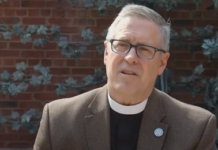Welcome banners proclaiming messages of indiscriminate affirmation paired with freshly installed labyrinths don’t appear to be slowing the ongoing Episcopal Church decline trend.
Statistics recently released by the Office of the General Convention show membership continued a gradual, uninterrupted drop of 36,214 persons to 1,676,349 (2.1%) in 2018, while average Sunday attendance declined 23,538 to 533,206 (4.2%). Across the denomination, nearly three-quarters of Episcopal parishes now have an average attendance of fewer than 100 persons. Median attendance across the church has dropped to 53. During the past five years, 59% of congregations have seen attendance declines of 10% or more.
The continued decline in members and attendees, even in major metropolitan areas, threatens the ability of the denomination to effectively continue ministry nationwide.
Outside of the state of Texas and Navajo Missions, no domestic diocese reports an increase in attendance, although declines vary widely. The northeastern regional Province 1 continues to shed attendance faster than any other region in the church, dropping 6.2%. Episcopal provinces are regional groups of dioceses, equivalent to Presbyterian synods or United Methodist regional jurisdictions.
The Episcopal Diocese of New Hampshire that first elected an openly partnered gay bishop in 2003 reported a 2018 attendance decline of 19.9%. The relatively traditionalist dioceses of Florida and Springfield (Illinois) reported declines of 0.7% and 0.8%, respectively. Excepting Navajo Missions, the smallest diocese by attendance continues to be Northern Michigan, which dropped 4.4% to 393 attendees and was the only diocese to record zero adult baptisms and zero confirmations in 2018. Shrinking dioceses have little incentive to juncture with neighbors: doing so would effectively forfeit an eight person deputation to General Convention, which is the same size deputation as larger dioceses like Texas (22,350 attendees) receive.
Geography continues to play a role in church decline, with several Rust Belt and Northeastern dioceses faring worse off than some southern dioceses, and dioceses with significant coverage of rural areas shrinking faster than those with larger urban populations. Formerly traditionalist dioceses now under progressive leadership seem to be faring especially badly. The Episcopal Diocese of Northern Indiana, where Democratic Presidential Candidate Pete Buttigieg was married and is a parishioner, shed 9.5% of attendees in a single year.
Children’s baptisms in domestic dioceses declined from 20,069 in 2017 to 18,873 in 2018 (6%). Marriages dropped from 7,687 to 6,878 (11%). Burials declined from 27,355 to 26,377 (4%). Child baptisms only outnumbered burials in two of the nine provinces. One of those (Province IX) is entirely overseas dioceses; the other (Province II) includes three overseas dioceses (Europe, Haiti, Virgin Islands).
Occasional Bright Spots
Despite sustained decline, the Episcopal Church didn’t shrink everywhere in 2018. Notably, non-domestic dioceses (many of whom did not support same-sex marriage rites) saw attendance nudge upward by 0.2%. Similarly, the denomination’s flagship church, the Washington National Cathedral, reports an attendance rebound from 1,200 to nearly 1,500 in 2018, even as plate-and-pledge dropped more than one third, possibly indicating an increase in Sunday visitors. The cathedral’s politically liberal and strident Dean Gary Hall was succeeded by Dean Randy Hollerith, who is less outspoken, in 2016.
In comparison, the wider Episcopal Diocese of Washington saw attendance drop 3.4 percent the same year. Nearby parishes reported decline, including neighboring St. Alban’s Episcopal Church, down from 500 attendees to 300 in the past decade. St. Columba’s, once the largest Episcopal parish in Northwest Washington, D.C., saw attendance drop from nearly 800 in 2008 to about 500 in 2018. St. Paul’s Parish, once a flagship church in the Anglo-Catholic tradition, has declined in attendance about 40 percent in the same time period. Changes in teaching appear to have played a role at St. Paul’s, where gay clergy joined the staff as same-sex marriage was introduced there.
Across the Potomac River, the historic Christ Church in Old Town Alexandria, Virginia, has struggled with departures after church officials announced plans to remove plaques commemorating historic church members President George Washington and General Robert E. Lee. In the past decade, Christ Church has dropped from approximately 700 Sunday attendees down to 400, while losing a quarter million dollars from it’s annual plate-and-pledge income. Membership has dropped from more than 2,500 down to approximately 1,500.
Further south in Virginia, the historic Lee Memorial Episcopal Church, now re-named Grace Episcopal Church, attendance has dropped from 225 in 2012 to 140 in 2018. Membership dropped from 425 to 275.
2018 statistics by province and diocese can be accessed here:
The church’s official 2018 table of statistics includes information on baptisms, confirmations, receptions, weddings and burials. It can be accessed by clicking here.
A report on the 2017 numbers can be viewed here.



